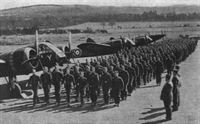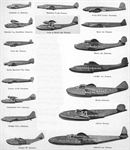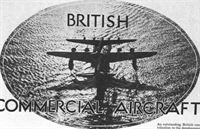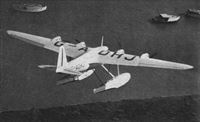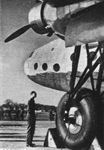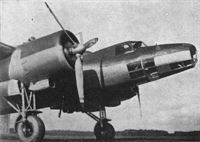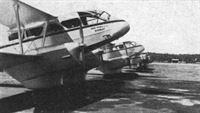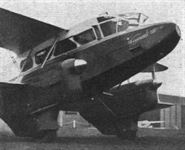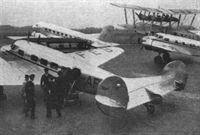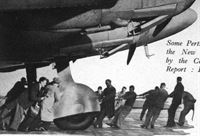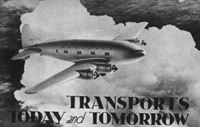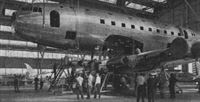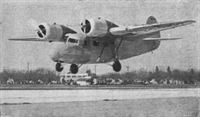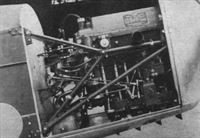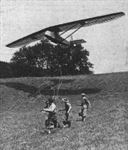Фотографии
-
"IT WAS A FAMOUS VICTORY." The Battle and the Blenheim make an appropriate background for the aircraft apprentices of Halton. The officers' mess is in the distance.
Самолёты на фотографии: Bristol Blenheim - Великобритания - 1936Fairey Battle - Великобритания - 1936
-
This photograph, taken at Hendon before the last R.A.F. display, is a history of production in itself, for the types shown range from the Virginia to modern Expansion bombers.
Самолёты на фотографии: Bristol Blenheim - Великобритания - 1936Handley Page Harrow / H.P.54 - Великобритания - 1936Vickers Virginia - Великобритания - 1922Vickers Wellesley - Великобритания - 1935
-
SKY SIGN: On the occasion of Field-Marshal Goering’s presentation of the first German-Austria flag to an Austrian Squadron, Austrian Fiat C.R.32 fighters made a swastika in the sky over Wienerneustadt. Field-Marshal Goering is commander-in-chief of the German Air Force. In the foreground can be seen a Dornier Do.17 fighter-bomber as fully described in an exclusive Flight article last week.
Самолёты на фотографии: FIAT CR.30 / CR.32 Chirri - Италия - 1932
-
Регистрационный номер: SE-BAB Overweather: One of A.B.<...>transport's Douglas D.C.3s.
Самолёты на фотографии: Douglas DC-3 / C-47 Skytrain/С-53 Skytrooper / Dakota - США - 1935
-
Самолёты на фотографии: Bloch MB.160 Languedoc - Франция - 1937Boeing Boeing 314 Clipper - США - 1938Consolidated PBY Catalina - США - 1935Dewoitine D.332 / D.333 / D.338 / D.620 - Франция - 1933Douglas DC-3 / C-47 Skytrain/С-53 Skytrooper / Dakota - США - 1935Douglas DF - США - 1936Focke-Wulf FW.200 Condor - Германия - 1937Junkers Ju.86 - Германия - 1934Latecoere Late 631 - Франция - 1942Liore et Olivier LeO H.246 - Франция - 1937Lockheed Super Electra 14 - США - 1937Martin Russian Clipper / Type 156 - США - 1937Potez Potez 661 - Франция - 1937Potez-CAMS Potez-CAMS 160 / 161 - Франция - 1938Savoia-Marchetti / SIAI SM.83 - Италия - 1937Sikorsky S-43 Baby Clipper/JRS/Y1OA-8 - США - 1936Sud-Est SE.200 - Франция - 1943
-
Do 24 разрабатывалась для авиации голландских ВМС (на фотографии), но состояла на вооружении еще пяти государств. Больше всего таких самолетов поступило в Люфтваффе.
Самолёты на фотографии: Dornier Do.24 - Германия - 1937
-
One of the most efficient military flying boats now in the air, tne Do.24 was built to the order of the Netherlands Government.
Самолёты на фотографии: Dornier Do.24 - Германия - 1937
-
Регистрационный номер: G-ADHJ [2], G-ADHK An outstanding British contribution to the development of commercial flying: the Mayo Composite aircraft.
Самолёты на фотографии: Short Mayo Composite (S.20 Mercury and S.21 Maia) - Великобритания - 1938
-
Регистрационный номер: G-ADHJ [2] Mercury, the shapely upper component of the Mayo Composite aircraft. This machine should make the transatlantic trip this year. The engines are four Napier Rapiers.
Самолёты на фотографии: Short Mayo Composite (S.20 Mercury and S.21 Maia) - Великобритания - 1938
-
GUARDING THE GATEWAY: A Hawker Hart (Kestrel IB) over the Suez Canal. The unfamiliar device on top of the engine cowling, resembling a waffle iron, is an air filter, now standard equipment Out East.
Самолёты на фотографии: Hawker Hart - Великобритания - 1928
-
The Beechcraft 18 (two Jacobs) with float undercarriage. A particularly adaptable type.
Самолёты на фотографии: Beechcraft Model 18 / C-45 Expeditor - США - 1937
-
MAKING WAY FOR THE YOUNG ’UNS: A symbolic picture of a new Miles Magister on a visit to one of the few R.A.F. stations with an Avro 504N still on charge. The 504 series (and later the Tutor) were, of course, in the very front rank of training aircraft. Even to-day the Tutor is finding wide employment, but will eventually be superseded by monoplane types.
Самолёты на фотографии: Avro Avro 504N - Великобритания - 1920Miles Magister / M.14 - Великобритания - 1937
-
Mr. J. Gadd, of Cirrus, inspects a Major 150 installed in a Miles Magister.
Самолёты на фотографии: Miles Magister / M.14 - Великобритания - 1937
-
Самолёты на фотографии: Armstrong Whitworth Ensign / A.W.27 - Великобритания - 1938
-
STRANGE CARGO: Two flamingoes, part of the odd zoological consignment unloaded from International Air Freight’s Curtiss Condors at Croydon last week.
Самолёты на фотографии: Curtiss Condor 18 - США - 1929
-
Самолёты на фотографии: Dornier Do.17 - Германия - 1934
-
The Do.17 as powered with two 950 h.p. Daimler-Benz D.B.600 inverted vee-twelves. This version is very fast indeed.
Самолёты на фотографии: Dornier Do.17 - Германия - 1934
-
A Do.17 for Yugoslavia with Gnome Rhone 14N0. engines. The cowlings are noteworthy.
Самолёты на фотографии: Dornier Do.17 - Германия - 1934
-
This specially prepared Flight drawing presents at a glance the layout of the Do.17 bomber-fighter. Actually the machine represented here is to some extent a “cocktail” version, embodying various optional features such as twin fixed guns in the top front fuselage decking. If need be, bombs may be carried externally, low on the sides of the fuselage. The inverted Daimler-Benz engines may be regarded as opposite numbers of our Merlin, though current ratings are slightly lower than for the Rolls-Royces. On the right, Gnome-engined version.
Самолёты на фотографии: Dornier Do.17 - Германия - 1934
-
Close-ups of (left) the retractable undercarriage and a section of the "double wing" of the Do.17 and (right) the somewhat unusual tail.
Самолёты на фотографии: Dornier Do.17 - Германия - 1934
-
On the left are details of the wing construction of the Do.17 showing the use of extruded sections. On the right is a fairly representative piece of fuselage construction.
Самолёты на фотографии: Dornier Do.17 - Германия - 1934
-
The striking general arrangement of the Do.17 as fitted with Gnome Rhone 14N0. engines for Yugoslavia. The wing, it will be noted, is of fairly low aspect ratio.
Самолёты на фотографии: Dornier Do.17 - Германия - 1934
-
Test rig for single rotor, including an electric motor for the drive. Lift and power required at different speeds were measured simultaneously.
Самолёты на фотографии: Focke-Wulf FW.61 - Германия - 1936
-
Fraulein Hanna Reitsch flying the F.W.61 inside the Deutschlandhalle in Berlin.
Самолёты на фотографии: Focke-Wulf FW.61 - Германия - 1936
-
Nose of the F.W.61. The propeller is merely a cooling fan. The three-wheeled undercarriage should be noted.
Самолёты на фотографии: Focke-Wulf FW.61 - Германия - 1936
-
160 h.p. Siemens Sh 14a engine, with clutch and transmission.
Самолёты на фотографии: Focke-Wulf FW.61 - Германия - 1936
-
Rotor head with blade hinges and incidence control.
Самолёты на фотографии: Focke-Wulf FW.61 - Германия - 1936
-
Вертолет Fw 61V1 в первом свободном полете. Бремен, 26 июня 1936 г.
An historical moment: The F.W.61 makes its first free flight, piloted by Ing. Rohlfs, on June 26, 1936. The fuselage had not yet been covered. Lateral and fore-and-aft control is by tilting the rotor heads.Самолёты на фотографии: Focke-Wulf FW.61 - Германия - 1936
-
Model of three-bladed rotor driven by 3 h.p. electric motor for tests in wind tunnel.
Самолёты на фотографии: Focke-Wulf FW.61 - Германия - 1936
-
Petrol-driven model (0.7 h.p.) in free flight
Самолёты на фотографии: Focke-Wulf FW.61 - Германия - 1936
-
Самолёты на фотографии: Miles Minor / M.30 X - Великобритания - 1942
-
NOT-SO-UNKNOWN QUANTITY: A wind-tunnel model of the projected 300-m.p.h. Miles X.2 four-engined transport. Although the layout is unorthodox in a number of senses no new problems in stability and control are involved.
Самолёты на фотографии: Miles Minor / M.30 X - Великобритания - 1942
-
Everyone familiar with the appearance of the Fokker Faucheur - illustrated several times in Flight - will acknowledge the accuracy of Mr. H. J. Towner’s model.
Самолёты на фотографии: Fokker G.I Le Faucheur - Нидерланды - 1937
-
Подвеска бомб под крыло летающей лодки, 1938 г.
Light bombs on a Kestrel-engined Singapore III, a type used extensively by Blueland for long-distance reconnaissance.Самолёты на фотографии: Short Singapore III / S.19 - Великобритания - 1934
-
Quick fill-up: No. 217 Squadron’s Ansons about to be replenished by “Mr. Zwicky” at Tangmere.
Самолёты на фотографии: Avro Anson / Type 652 - Великобритания - 1935
-
Регистрационный номер: SU-AAO, W204 The Avro 652 transport in its later form - actually - one for the Egyptian Government. The well-known Anson was developed from the 652, two of which were used by Imperial Airways.
An adaptable feederline or charter type is the Cheetah-powered Avro 652Самолёты на фотографии: Avro Anson / Type 652 - Великобритания - 1935
-
A Fairey Swordfish torpedo spotter reconnaissance machine (690/750 h.p. Bristol Pegasus III) taking off from the Courageous turns almost immediately the wheels are clear of the deck in order to clear the way for the next man off. The steam jet, which shows when the shin is headed dead into wind, is in prominence.
Самолёты на фотографии: Fairey Swordfish - Великобритания - 1934
-
Регистрационный номер: K8080 В полете - звено самолетов "Уайлдбист" IV из 42-й эскадрильи
SLEEVE-VALVES IN SERVICE: Vickers Vildebeest IV torpedo bombers (Bristol sleeve-valve Perseus VIII) approach the “convoy” during the recent Combined Exercises.Самолёты на фотографии: Vickers Vildebeest / Type 132 - Великобритания - 1928
-
OVER THE CHANNEL: Vildebeests of No. 42 (T.B.) Squadron on the way to torpedo a "convoy" in the Channel seen from the gunner's cockpit of a consort.
Самолёты на фотографии: Vickers Vildebeest / Type 132 - Великобритания - 1928
-
Pioneers in India: part of the Tata fleet at Bombay
Самолёты на фотографии: De Havilland Dragon Rapide / Dominie / D.H.89 - Великобритания - 1934
-
Type which have done an enormous amount of pioneer work on airlines in all parts of the world: the D.H.89, or Dragon Rapide
Самолёты на фотографии: De Havilland Dragon Rapide / Dominie / D.H.89 - Великобритания - 1934
-
In South America: A Sedta Junkers leaving Quito for Guayaquil. The company was started by Herr Hammer, one of the pioneers of South American air transport.
Самолёты на фотографии: Junkers W 33 / W 34 / Ju.46 - Германия - 1926
-
Регистрационный номер: G-ACJJ, G-AFEB, PH-AKT London’s Terminal : British Airways, imperial Airways and K.L.M. on the tarmac at Croydon.
Самолёты на фотографии: Douglas DC-1 / DC-2 / C-32 / C-39 - США - 1933Lockheed Electra 10 - США - 1934Short Scylla / L.17 - Великобритания - 1934
-
Outstanding among the landplanes is the D.H. Albatross, which makes use of the compact D.H. Gipsy Twelves. The tail is now cantilever with the fins and rudders at the extremities.
Самолёты на фотографии: De Havilland Albatross / D.H.91 - Великобритания - 1937
-
“A Government order for a transatlantic mail carrier, placed in 1936, provided a small part of the immense development cost of the Albatross.”
Самолёты на фотографии: De Havilland Albatross / D.H.91 - Великобритания - 1937
-
Регистрационный номер: G-AEYE [2], G-AFFD [2], YI-ROH [2] A well-arranged trio of Percival Q.6 monoplanes (two Gipsy Six II). This type is likely to make its mark as a small commercial type.
Самолёты на фотографии: Percival Petrel / Q.6 - Великобритания - 1937
-
Регистрационный номер: G-AEYE [2], G-AFFD [2], YI-ROH [2] CIVIL FORMATION: A pleasant impression of three of the new Percival Q.6 monoplanes, specially “posed” by their pilots for Flight's photographer. The nearest, which is painted flame and yellow, is for King Ghazi; next is the demonstrator; and third is Sir Philip Sassoon's. The Q.6 is a feeder-line, charter or luxury private-owner type, and is fitted with the Gipsy Six Series II.
Самолёты на фотографии: Percival Petrel / Q.6 - Великобритания - 1937
-
ROYAL EQUIPMENT: Inside King Ghazi’s Percival Q.6. On the right is the very complete Marconi two-way radio equipment with D F (or homing) loop, the graduated control wheel of which can be seen at the top of the picture. Interesting features of the Q.6 dashboard are the trimming cranks on the throttle bank, the D.H. constant-speed airscrew controls at the top of the dash to the right of the throttles, and the vacuum-operated flap control below the airscrew levers. All the six seats have Irvin seat-type parachutes.
Самолёты на фотографии: Percival Petrel / Q.6 - Великобритания - 1937
-
P.O. AT ST. MORITZ: The Hon. Drogo Montagu sends this snap, which he took recently at the St. Moritz mountain airport. He says that the machine shown, Mr. Ian Walker’s Vega Gull, was the first British privately owned aircraft to land there.
Самолёты на фотографии: Percival Vega Gull / K.1 - Великобритания - 1935
-
Mr. Broadbent waves on his arrival at Hanworth for the benefit of the news cameramen. The actual flight had ended at Lympne last Friday
Самолёты на фотографии: Percival Vega Gull / K.1 - Великобритания - 1935
-
Регистрационный номер: G-AETZ Empire debarkation: The new pontoon gangway at Berth 10, New Dock, Southampton.
Passengers coming ashore at the Imperial Airways terminal at Southampton in April 1938.Самолёты на фотографии: Short Empire / S.23 - Великобритания - 1936
-
Регистрационный номер: G-ADUU The Short Empire boat, demonstrating the use of the Gouge flaps which contribute in no small measure to its excellent performance.
Самолёты на фотографии: Short Empire / S.23 - Великобритания - 1936
-
Регистрационный номер: F-AOHB New type for Air France: The Bloch 220
Самолёты на фотографии: Bloch MB.220 - Франция - 1936
-
Регистрационный номер: F-AQBF New type for Air France: The trimotor Dewoitine D.338.
Самолёты на фотографии: Dewoitine D.332 / D.333 / D.338 / D.620 - Франция - 1933
-
Регистрационный номер: D-AMIE The Blohm and Voss Hamburger floatplane with four Junkers Jumo diesels - a type catapulted from Lufthansa’s “floating aerodromes.”
Самолёты на фотографии: Blohm und Voss Ha.139 - Германия - 1936
-
Регистрационный номер: D-AJIE Intended for long-distance mail-carrying, this new Heinkel has four 240 h.p. Hirth inverted vee-eights.
Самолёты на фотографии: Heinkel He-116 - Германия - 1937
-
Самолёты на фотографии: Boeing Boeing 307 Stratoliner - США - 1938
-
Cabin arrangements of the Boeing Stratoliner, which will accommodate 33 passengers by day or 25 by night. Just aft of the control cabin is the men’s dressing room, and then four compartments - the first two shown made up for night travel. On the near side are nine chairs for short-trip passengers. At the rear are the women’s dressing room and the galley.
Самолёты на фотографии: Boeing Boeing 307 Stratoliner - США - 1938
-
Air, drawn in through the leading edge of each wing, is compressed by the superchargers, warmed, and circulated as shown in this diagram.
Самолёты на фотографии: Boeing Boeing 307 Stratoliner - США - 1938
-
Регистрационный номер: NX18601 Final assembly, in the open air, of the Boeing Atlantic Clipper, which will be powered with four of the new two-row, 1,500 h.p. Wrights. "Sea-wings" provide lateral stability on the water and facilitate embarkation of passengers.
Самолёты на фотографии: Boeing Boeing 314 Clipper - США - 1938
-
Seating the fuselage of the Douglas D.C.4 on to the wing. A tricycle undercarriage is specified for this machine ; the engines will be four Pratt and Whitney Twin Hornets.
Самолёты на фотографии: Douglas DC-4E - США - 1938
-
Самолёты на фотографии: Lockheed Electra 10 - США - 1934
-
Самолёты на фотографии: Lockheed Electra 10 - США - 1934
-
PLOUGHSHARE AND SWORD: Civil and military versions of the Lockheed 14 monoplane, sometimes called the Zephyr. The transport machine does over 260 m.p.h. with two Cyclone Gs; turrets will detract from the performance. The bomb stowage is interesting, an advantage being that only a comparatively small hole has to be cut in the skin covering of the fuselage for the bombs to <...>
Самолёты на фотографии: Lockheed Super Electra 14 - США - 1937
-
Регистрационный номер: NX1307 AMPHIBIAN FIGHTER - Virtually the so-called “Convoy” fighter with amphibian gear, this machine is seen before being dismantled for shipment from America to Russia. If the wings are used as tanks a range of 6,000 miles is claimed to be possible. By interchanging wing panels and power units the machine can be used as a trainer, for observation, or as a light bomber. Quantity production in Russia is probable.
Самолёты на фотографии: Seversky SEV-2PA / AT-12 - США - 1937
-
MIDLANDS CENTRE: The terminal building and hangar at the new Wolverhampton aerodrome - with a small portion of Mr. J. R. Bryan’s Reliant in the right foreground. The Midland Aero Club are providing the club flying facilities there, while Boulton Paul already give a manufacturing atmosphere. The latter’s works, incidentally, make an excellent landmark when the aerodrome is being approached in poor visibility.
Самолёты на фотографии: Stinson Reliant - США - 1933
-
BREAKING NEW GROUND: The new Timm light transport which takes advantage of Handley Page slots and slotted flaps and does over 200 m.p.h. on a pair of Wright Whirlwinds. View and landing characteristics should be superior to those of the majority of commercial machines in the air to-day.
Самолёты на фотографии: Timm T-840 Aeromold Transport - США - 1938
-
Регистрационный номер: G-ACSS [3] Самолёты на фотографии: De Havilland Comet / D.H.88 - Великобритания - 1934
-
Регистрационный номер: G-ACSS [3] The Comet welcomed at Croydon on its return from the record flight.
Самолёты на фотографии: De Havilland Comet / D.H.88 - Великобритания - 1934
-
Регистрационный номер: G-ACSS [3] An unorthodox snapshot of Clouston and Ricketts, amusingly suggestive of the famous painting, “The Death of Nelson.’’ They are watching the Comet being prepared in the works of Essex Aero Ltd., at Gravesend.
Самолёты на фотографии: De Havilland Comet / D.H.88 - Великобритания - 1934
-
The Airspeed Convertible Envoy shows great versatility in military and commercial fields. Two Siddeley Cheetahs are normally specified.
Самолёты на фотографии: Airspeed Envoy / AS.6 - Великобритания - 1934
-
Cirrus Minor installation showing clearly the engine’s small size, in a Blackburn Bluebird used for testing purposes
Самолёты на фотографии: Blackburn Bluebird / L.1 - Великобритания - 1924
-
Регистрационный номер: NC14716 China Clipper: One of the Martin boats used for the P.A.A. trans-Pacific service.
Самолёты на фотографии: Martin China Clipper / Type 130 - США - 1934
-
The Pobjoy-powered Scion is available as a landplane or on floats.
Самолёты на фотографии: Short Scion / S.16 - Великобритания - 1933
-
Cirrus Minor engines have found their way to many distant lands; The Butler monoplane, which hails from Australia;
Самолёты на фотографии: Butler BAT - Австралия - 1937
-
Cirrus Minor installation in a B.A. Swallow
Самолёты на фотографии: British Klemm L.25 Swallow - Великобритания - 1933
-
Самолёты на фотографии: Short Kent / S.17 - Великобритания - 1931
-
Самолёты на фотографии: Lippisch / RRG Prufling - Германия - 1926
-
Самолёты на фотографии: Lippisch / RRG Falke - Германия - 1930
-
Регистрационный номер: G-AELZ This modified Dart Flittermouse has characteristics which lead its owner to hope that real soaring flight, with the 28 h.p. Scott engine switched off, will be possible in the right atmospheric conditions.
Самолёты на фотографии: Dart Flittermouse - Великобритания - 1936
Статьи
- Flight
- Flight Advertisements
